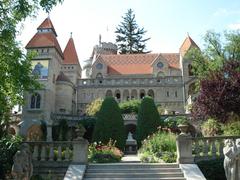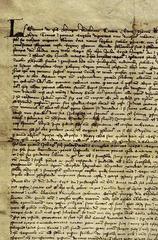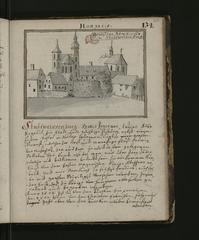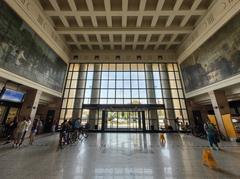Visiting Püspöki Palota: Hours, Tickets, and Travel Tips
Date: 01/08/2024
Introduction
Nestled in the historic city of Székesfehérvár, Hungary, the Püspöki Palota stands as a testament to the rich architectural, religious, and cultural heritage of the region. Constructed between 1788 and 1801, this magnificent palace showcases the elegant transition from the Baroque to Neoclassical styles, making it a significant landmark in Hungarian architectural history. The Püspöki Palota is more than just a visual marvel; it is a repository of cultural and historical artifacts that offer visitors a deep dive into the religious and intellectual history of Székesfehérvár. This comprehensive guide aims to provide potential visitors with all the necessary information to make their visit as enriching and seamless as possible, covering aspects such as the palace’s history, visiting hours, ticket prices, travel tips, and more (source) (source).
Table of Contents
History of Püspöki Palota, Székesfehérvár
Construction and Architectural Style
The Püspöki Palota in Székesfehérvár serves as the central hub for the Székesfehérvári Diocese. This architectural marvel is situated at Városház Square. The construction of the palace spanned from 1788 to 1801, embodying the Empire and Copf architectural styles. These styles are characterized by their elegant simplicity and classical influences, prevalent during the late 18th and early 19th centuries. The palace’s design reflects the transition from the ornate Baroque to the more restrained Neoclassical style, making it a significant example of this architectural evolution in Hungary (source).
Historical Significance
The Püspöki Palota holds immense historical significance as it is not only a religious center but also a repository of cultural and historical artifacts. The palace houses the Püspöki Könyvtár (Bishop’s Library), which boasts an impressive collection of approximately 40,000 volumes. This includes medieval codices and incunabula, making it one of the most important collections of early printed books in Hungary. The library’s collection provides invaluable insights into the religious, cultural, and intellectual history of the region (source).
Role in the Diocese
As the residence of the bishop, the Püspöki Palota has been the epicenter of the Székesfehérvári Diocese’s activities for centuries. The diocese itself has a rich history, having been established in the early medieval period. The palace has witnessed numerous significant events, including episcopal consecrations, diocesan synods, and other ecclesiastical gatherings. It has also played a crucial role in the administration and governance of the diocese, serving as the bishop’s official residence and office (source).
Cultural and Educational Contributions
The Püspöki Palota is not just a religious and administrative center; it also contributes significantly to the cultural and educational landscape of Székesfehérvár. The Székesfehérvári Egyházmegyei Múzeum (Diocesan Museum) is located nearby and offers a rich array of exhibits that highlight the religious and cultural history of the region. The museum’s collections include liturgical objects, paintings, sculptures, and textiles, many of which date back to the medieval period. These exhibits provide a comprehensive overview of the diocese’s artistic and cultural heritage (source).
Notable Exhibitions and Publications
The Székesfehérvári Egyházmegyei Múzeum has hosted numerous notable exhibitions over the years. For instance, the “Baroque Heaven” exhibition, held from August 3 to October 23, 2018, showcased the rich Baroque heritage of the region in collaboration with the Szent István Király Múzeum. Another significant exhibition was “István, the Holy King,” which ran from August 31 to December 11, 2013, and focused on the life and legacy of Saint Stephen, the first King of Hungary (source).
In addition to exhibitions, the museum has published several scholarly works that delve into various aspects of the diocese’s history. These publications include “Szent László kora és kultusza” (The Era and Cult of Saint Ladislaus), which explores the veneration of Saint Ladislaus, and “A fehérvári keresztes konvent története” (The History of the Fehérvár Crusader Convent), which examines the role of the crusader convent in the late medieval period (source).
Restoration and Preservation Efforts
Over the years, significant efforts have been made to preserve and restore the Püspöki Palota and its associated buildings. These efforts ensure that the architectural integrity and historical significance of the palace are maintained for future generations. Restoration projects have focused on various aspects of the palace, including its structural stability, interior decorations, and the preservation of its extensive library and museum collections. These projects are often supported by both the diocese and external funding sources, highlighting the importance of the palace as a cultural and historical landmark (source).
Visitor Information
Visiting Hours and Tickets
The Püspöki Palota and the Székesfehérvári Egyházmegyei Múzeum are open from Tuesday to Saturday, 10 AM to 6 PM. Tickets can be purchased at the entrance, and guided tours are available for an enhanced experience. It is advisable to check the official website for the most up-to-date information on ticket prices and any special events (source).
Travel Tips
Székesfehérvár is well-connected by public transport, and the Püspöki Palota is easily accessible from the city center. For those driving, parking is available in nearby lots. Visitors are encouraged to wear comfortable shoes as there is much to explore. Photography is allowed in most areas, but be sure to check for any restrictions.
Special Events and Guided Tours
The Székesfehérvári Egyházmegyei Múzeum frequently hosts special events, including temporary exhibitions and cultural programs. Guided tours are available and provide deeper insights into the history and significance of the palace and the diocese. It is recommended to book tours in advance to ensure availability.
FAQ
What are the visiting hours for Püspöki Palota? The Püspöki Palota is open from Tuesday to Saturday, 10 AM to 6 PM.
How much are tickets to Püspöki Palota? Ticket prices vary and can be checked on the official website for the most current information.
Is photography allowed in Püspöki Palota? Yes, photography is allowed in most areas, but it is advisable to check for any restrictions.
Conclusion
The Püspöki Palota in Székesfehérvár stands as a testament to the rich religious, cultural, and architectural heritage of Hungary. Its historical significance, coupled with its role as a center for education and cultural preservation, makes it an invaluable asset to the region. Visitors to the palace and its associated institutions can expect a comprehensive and enriching experience that offers a deep dive into the history and culture of Székesfehérvár and the broader Hungarian context. Don’t miss out on this must-visit destination during your travels (source) (source).
References
- Püspöki palota (Székesfehérvár). Wikiwand. https://www.wikiwand.com/hu/Püspöki_palota_(Székesfehérvár)
- Székesfehérvári Egyházmegyei Múzeum. Székesfehérvár Katolikus. https://www.szfvar.katolikus.hu/gyujtemenyek/muzeum/muzeum-informaciok/
- Püspöki Palota, Sümeg. Természetjáró. https://www.termeszetjaro.hu/hu/poi/kastely/puespoeki-palota-suemeg-/26280785/
- Püspöki Palota. Pécsi Egyházmegye. https://pecsiegyhazmegye.hu/latnivalok/puspoki-palota





